Engagement Ring
“Love is no assignment for cowards.”
— Ovid (Roman poet)
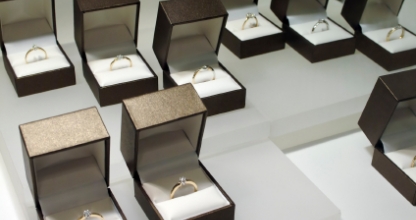
Setting
Without her knowing, find the answers to these questions:
- Are most of her rings Yellow Gold, White Gold or Platinum?
- Are her rings simple or extravagant?
- Are her rings more modern looking or antique?
- Are the bands of her rings thin or thick?
- How many prongs do her rings have 4, 6 or more?
- Do her rings have a single stone, multiple stones or both?
- Are there little stones on the side resembling a Channel, Bar, Flush or Pave arrangement?
-
Does she have, or did she ever mention liking a Cathedral, Bezel or Tension setting?
Tips:
-
Make sure the ring is NOT too small.
You want it to fit on her finger during the proposal… it can be resized later (just be sure to get the whole ring insured in case it slips offer her finger and gets lost). To help with sizing, you can do any or all of the following (her finger size may vary, so go a little bigger just in case):
- Put one of her rings on your pinky finger and mark your finger where it stops
- Trace the inside of one of her rings on paper
-
Consider a temporary setting.
Just use the actual diamond you’ve picked, and have her pick out the actual band after you propose.
-
Consider the environment she works in.
Some settings leave the diamond too exposed.
Shape
Most women have a good idea what shape they want, so be sure to find out hers. The most common shapes are Round and Princess.
-
Round-Cut Diamond:

-
Princess-Cut Diamond:

-
Emerald-Cut Diamond:

-
Marquise-Cut Diamond:

-
Asscher-Cut Diamond:

-
Cushion-Cut Diamond:

-
Oval-Shaped Diamond:

-
Heart-Shaped Diamond:

-
Pear-Shaped Diamond:

-
Trillion-Shaped Diamond:

-
Radiant-Cut Diamond:

Images Provided by Diamond Safe
Color
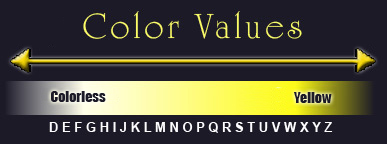
- D diamonds are the whitest
- E and F diamonds have no detectable color to the naked eye
- G to J diamonds remain near colorless
- J to M diamonds may have a faint trace of yellow
-
N and below diamonds will show noticeable yellow tones
Tips:
-
Know what the best value is.
H & I diamonds are considered to have the best value. -
Do an accurate comparison.
To do a true color quality comparison, place the diamonds next to each other on white paper. -
Even the best diamonds could show color.
A clear diamond will naturally bring out some of the metal color from the setting. -
Diamonds do come in colors.
There are also rare pink, blue and green diamond options. -
Fluorescence does play a part.
Look for diamonds that have a fluorescence rating of none or faint.
Clarity
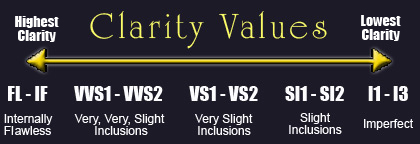
- Flawless and Internally Flawless grade diamonds have the highest clarity
- VVS1-VVS2 and VS1-VS2 grade diamond inclusions are very difficult to see with 30x’s magnification
- SI1-SI2 grade diamond inclusions are easily seen through 10x’s magnification, but not the naked eye
-
I1-I3 grade diamond inclusions are easily seen through 10x’s magnification and by the naked eye
Tips:
-
Know what the best value is.
The VS1-VS2 range is considered to have the best value. -
Flawless may not mean entirely.
It’s rare, but Internally Flawless Diamonds may have external imperfections. -
Know what an inclusion is.
Inclusions are typically mineral deposits that did not crystallize. -
An inclusion’s position means something.
When comparing diamonds within the same clarity grade, avoid inclusions that are in a more noticeable position (especially if the size and number of inclusions are the same). -
How you compare is important.
Be sure to compare diamonds under magnification to see their inclusions. -
Don’t pay too much for nothing.
Stay away from clarity enhanced diamonds. These were badly cut diamonds that jewelers have tried to fix.
Cut
In this section you'll focus on the diamond's proportion, symmetry and polish. Each of those elements will affect the way a diamond reflects light and sparkles (its brilliance). This is why a diamond’s “cut” is the most important “c” of the four major diamond evaluation criteria (cut, color, clarity and carat). Keep in mind that each facet (side) of an “ideal” diamond aligns perfectly with the one across from it, so the more precise the diamond is in this way, the higher the quality. The following illustrations show how light passes through a diamond based on its cut.
-
Example 1:
This diamond’s cut is too shallow, leaving it dark on top.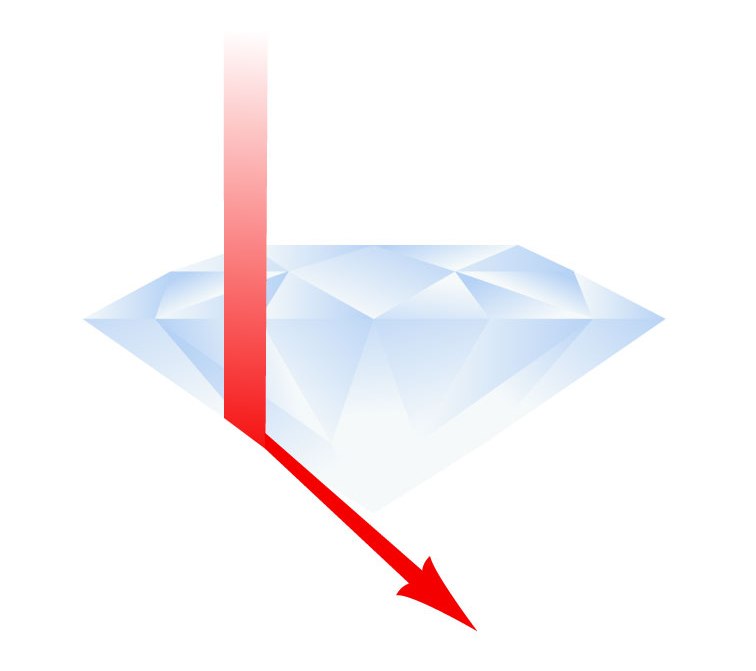
-
Example 2:
This diamond’s cut is too deep, leaving it looking dull and smaller.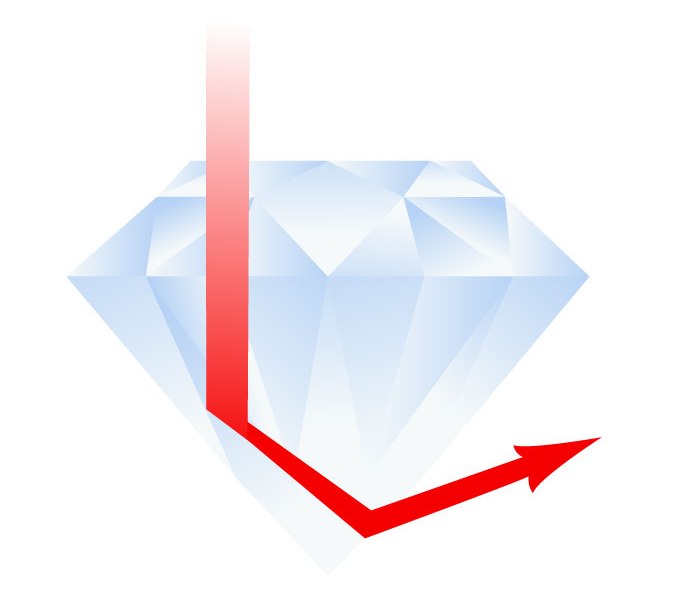
-
Example 3:
This diamond’s cut is optimal in size and brilliance.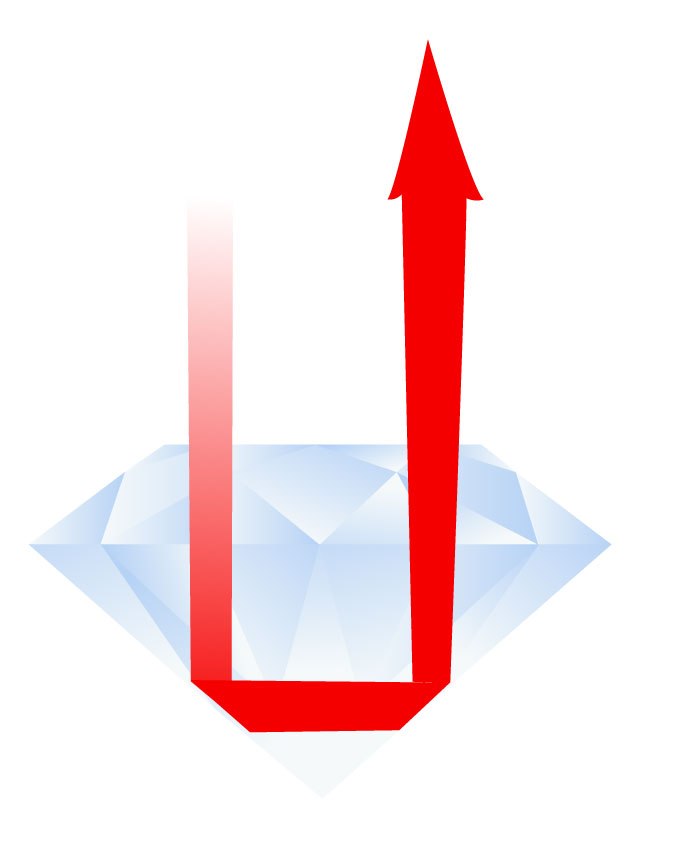
Tips:
-
The smaller the tip of the diamond, the better.
Look for the bottom tip of the diamond (culet) to be listed as any of the following: pointed, no culet, very small, small or medium. -
The thinner the rim of the diamond, the better.
Look for the girdle thickness (outer most rim of the diamond) to be very thin, thin, medium, slightly thick or thick. -
The polish of the diamond is important.
Make sure the polish grade is good, very good, excellent or ideal. -
The clarity and symmetry of the diamond are closely linked.
The greater the clarity the more important symmetry becomes, so look for good, very good, excellent or ideal (very good, excellent and ideal ratings are rare).
Carat
The size of the diamond is not as important as the overall quality. In the end, you want the diamond to be the right size for the setting and her finger.
Tips:
-
Get the most diamond for your money.
The best value is finding a diamond in either
the ¾ carat range, or just under 1 carat. -
Know her finger size.
The smaller her finger, the smaller the carat
size can be. -
The band’s width makes a difference.
The wider the band, the bigger the diamond
should be.
Certification
This is a documentation of authenticity that identifies all the characteristics of the diamond and setting to establish its true value. This information will also enable you to accurately insure the entire ring with your insurance company (note: once you give her the ring it is no longer your property, so make sure the ring is insured under her name until you are married). The annual cost for insurance will depend on the total value of the ring, but it’s minimal. Below are the top three certification companies:
Tips:
-
Make sure it’s from one of the top three companies.
Find an independent gemologist who is affiliated with one of these companies. -
Keep in mind who set the standards for diamond grading.
GIA created the 4Cs and is the source of gem knowledge and grading standards used worldwide. -
The EGL could save you money.
You may be able to get the same quality diamond for less if it’s certified by the EGL. -
Certifiers do have specialties.
AGS certifiers are known to be the best at grading the cut of a diamond. The better the cut, the more likely it is to have a greater brilliance (sparkle)
Purchase Tips
There’s a lot to consider before buying a diamond ring. And even when you’re ready to buy, it’s always a good idea to try to get the best value for your money.
Tips:
-
Know what you want to spend.
Traditionally, grooms spend about 15% of their annual gross income on the engagement ring. Still, it’s important to go with a comfortable budget. -
Ask about affiliations.
Make sure your jeweler is affiliated with the American Gem Society or local Better Business Bureau. -
Too good to be true… it probably is.
Watch out for heavily discounted diamonds… there’s probably a catch. -
Get the weight per diamond.
Don’t be misled by the total carat weight (TCW). You want to know the carat weight for each diamond on the ring… not just all of them combined. -
Don’t pay sticker price.
Don’t be afraid to negotiate the price. Insist on seeing the jeweler’s copy of the Rapaport Diamond Report. This will show the diamond’s wholesale price. Know that if you pay that amount, the jeweler will still make a profit. -
Buy separately.
Buy diamond(s) separate from the setting. -
Pay in cash.
If you are able to pay for the diamond(s) with cash, you should get a better deal. -
Get the facts on what you’re buying.
Be sure the jeweler gives you all the ratings for your diamond in writing. -
Grading is grading for a diamond.
Costco and Sam’s Club diamonds are graded the same as traditional diamond dealers. -
Where your diamond was mined makes a difference.
Look for a conflict-free diamond. This means the profit made by the seller does not pay for war related activity, and the diamond is NOT mined or produced under unethical conditions. To ensure this type of certification is accurate, you must trace the diamond through a certified program from the mine to you. For more information visit: Conflict Free Diamonds.org. For a place to shop, visit: greenkarat.com -
Look out for fakes.
Fake diamonds like Cubic Zirconia will be like glass. You’ll be able to see right through to whatever is below it, and not the bottom of the stone like a real diamond. -
Understand your options after the purchase.
Be sure to review the jeweler’s repair, upgrade, return and cash refund policies.

